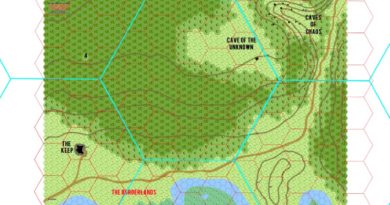Building the Perfect Class
Creating new and balanced classes for any campaign
Play D&D long enough, and it’s inevitable that you’ll want (or need) to tweak an existing character class or create one of your own. There are many approaches to doing so, but if you’re like me (i.e., you have OCD and believe that everything can be represented by numbers), you want a process that’s consistent, that meshes with the existing rules, and that doesn’t take a lot of time (because maybe you want to add many classes to your campaign). Luckily (and largely because I have OCD), this article provides just that process, which allows you to create or customise any class you want, using any race and a variety of abilties, all without unbalancing your campaign.
Getting Started
For brevity, the class creation instructions are located in the PDF attached to this article, Building the Perfect Class. I suggest you download the article, read it thoroughly, and follow the instructions given. But since no one actually reads manuals, here’s the short version:
How it Works
Building the Perfect Class assumes that each class is, in dry terms, a collection of abilities and that every ability can be represented by an XP value. If you total the XP for each ability, you can figure out how many experience points are needed for each level. The trick to achieving game balance with the canonical classes is making sure each ability’s XP value is consistent. To do this, I reverse-engineered each class by breaking out component abilities and assigning XP values until my results matched the level advancement tables. While this probably isn’t how the classes were built, the results (with one notable exception) were sufficiently precise to form a solid foundation.
With consistent XP values known, one could then mix and match abilities to create new classes, or simply customize classes that already existed. The PDF article explains how to do this, but it’s a very simple process: because I bothered to “show my work,” it actually takes more time to read the material than to simply crank out a few examples.
Quick and Dirty
To speed things along, you can use the attached Excel spreadsheet (class_xp.xls), which contains all the abilities, XP values, and experience point tables from the article. Just open the spreadsheet and start creating your own classes in the section titled, “Enter Your Classes Below.”
Final Note
I’m always interested in the classes people create, mostly because we all have different interpretations of what a “ranger” is, or what weapons a halfling thief is allowed to use. There are certainly no wrong answers, and the system here is infinitely scalable. So when you’re done building your perfect class, follow our posting guidelines to share it on this site. I’d love to see what you come up with!
UPDATE – Dec 24, 2013
I’ve added a revised XP Calculator to remove zero-XP values (this prevents munchkins from gaming the system with 0XP requirements). To make the numbers work, I combined the “Special I” and “Special II” categories, and broke out “bundled” skills, like thief and mystic abilities. As a result, the categories and values don’t precisely match those described in the PDF. On the plus side, this approach provides greater parity for the Magic-User class. Enjoy!




Interesting work. However that’s not really how classes were built by Gary, Dave and Co. . They were eyeballed and built with a theme in mind, then gradually adjusted in abilities, mechanics and XP requirements until they all seemed viable (at least as far as how Gary played). Even with his higher XP the MU is the most ‘powerful’ core class, and the Thief is mediocre, but they’re both playable and archetypal, which was the point. The XP tables for the Elf in the Rules Cyclopedia are also way too high.
There’s nothing more subjective than balance and fairness. I hardly even use Dungeons in my game, play with small parties who don’t bother/needn’t be have one of every class and encourage combat avoidance, which makes Charm Person about the most powerful ability there is. I think getting to create mechanical/numerical equivalence ignores a very simple fact: there is no a priori situation or goal in an RPG. Trying to find equivalence in inequality is the brain damage of liberalism, heh, every equality creates an inequality in another dimension. It’s literally meaningless.
Hi Urizen,
I hear you – early editions of D&D really didn’t bother much with balance. And, as the article states, I’m confident that the game authors used no such system to assign XP requirements.
That said, I challenge your assertion that it’s “literally meaningless.” Just because a style of play eschews enforced balance doesn’t invalidate the exercise’s findings. There is a pattern behind the XP numbers – albeit unintended – and if one is so inclined, one might make use of that pattern to provide a level of balance found lacking (should it be desired).
My goal in “reverse engineering” the classes is to provide a consistent set of values for those who want it, perhaps because they’re not comfortable eyeballing new classes, or because they lean toward the OCD side of things (like me). Plus it was a fun effort in Being A Nerd. But by all means, it’s not an apologist stance on the need for game balance, particularly where balance is not a priority.
It would be fun to make a random class generator based on this structure.
Pingback: Balance: There Ain’t No Such Critter | XpertCliques
I love the systematic approach in the article which opens up so many routes for people to develop their own character classes. It’s great! 🙂
UPDATE 8/16/15: I posted an updated and revised version of this framework at Building a More Perfect Class. It fixes the zero-XP issues the munchkins liked to abuse, and consolidates special and racial abilities to make the calculator a little easier and faster.
Are you able to share the special abilities and skills listed for the New Classes like Mage (improved), Bard, Skald, etc? My son and I are trying to figure a few of them out, like what the 3 Special are for Mage. We noticed in a previous generation of your spreadsheet and post, you had Special II which we figured were at 3x the cost of a Special I. Btw, we love what you’ve done. We’ve just started playing RC as a family.
Hi Adam,
Thanks for the kind words, and I’m glad you’re getting use out of this.
The special abilities and skills are outlined as comments in the spreadsheet, though they’ve been updated in the Building a More Perfect Class version (they’re no longer broken out into Special I and Special II). That said, here are the *original* specials and skills:
# Special Abilities:
* Backstab
* Cast Magic Spells in Armour
* Fighter Combat Options
* Gentle Touch (as mystic)
* Increased Movement (as mystic)
* Incremental AC bonus (as mystic)
* Inherent Spell-casting (1/3 spell levels)
* Lance Attack
* Martial Arts (as mystic)
* Multiple Attacks (as mystic)
* Read Spell Scrolls
* Set Spear vs. Charge
* Special Attack (non-racial ability)
* Special Defence (non-racial ability)
* Turn Undead
# Skills:
* Acrobatics (as mystic)
* Awareness (as mystic)
* Blankout (as mystic)
* Climb Walls (as thief)
* Find Traps (as thief)
* General Skill (per skill)
* Heal Self (as mystic)
* Hear Noise (as thief)
* Hide in Shadows (as thief)
* Mind Block (as mystic)
* Move Silently (as thief)
* Open Locks (as thief)
* Pick Pockets (as thief)
* Read Normal Languages (as thief)
* Remove Traps (as thief)
* Resistance (as mystic)
* Speak w/Animals (as mystic)
* Speak w/Anyone (as mystic)
The specials for Mage are: detection, inherent spell-casting, and reading spell scrolls.
So well done! Did you consider attack ranks and the monstrous classes from the creature crucibles? I’m still doing the math on a BECMI class / race seperation instead of making a bajillion classes.
Hi Justin,
The attack ranks are built into the “THMod” (to-hit modifier) cost for demi-humans (300XP), but it’s a quick-and-dirty, blanket approach.
I didn’t work out the monstrous classes (i.e., those starting at negative XP), but if I wanted a monster class, I’d translate the monster’s abilities to class abilities and figure the base XP normally. Then, start the character at 1st level and gradually add/strengthen those abilities so that they’re full-strength when the character’s level equals the monster’s HD. For example, a troll character’s regeneration might start at 1hp for levels 1-3, 2hp at levels 4-5, and 3hp at levels 6+). Remember that the base XP includes every ability, no matter what level it’s earned.
Let me know if that helps!
Some monstrous abilities are very powerful (save or die poison, petrification, etc) there would need to be a Special III XP Cost category for them, I think.
Overall your work has helped me greatly. I have been thinking about BECMI with class race separation similar to how Old School Essentials presents it, but I still wanted attack ranks and high level limitations. Now I’m thinking making a huge class list might be a better option now that I have a tool to assemble them.
Hi Justin,
This may be easier than you think. I double-checked attack ranks after your note yesterday, and I wouldn’t change the XP cost for Demi-humans. The XP cost reflects the rate of “to-hit” improvement, which for demi-humans is slightly better than fighters after max level, but worse than monsters below.
For monstrous abilities, you really have carte blanc. The system was built using existing class abilities, so there’s no basis for how many XP monstrous abilities should cost. I’d start by trying to fit these into Special I or Special II (and, to be honest, if I had to do this over again, I’d try to normalize those into a single category).
My unsolicited advice on a huge class list vs. race / class separation is that the former works best when tied to a specific setting. While the latter is more flexible, I find it leads to a hodge-podge of options that can sometimes require more effort to justify in a campaign.
All that said, keep us posted – I’d like to see what you come up with!